Rich in scenic wonders, the paradise on Earth - Kashmir - is as rich in spectacular landscapes, water bodies, and other picturesque marvels, as it is rich in handicrafts. From handmade carpets to Papier Mache articles, walnut wood luxury products to the labyrinthine wicker willow, from copper carving to shawl making, Kashmir is the hub of breathtaking art forms. Yet amongst all, the most cherished throughout the world is shawl making. Pure Pashmina shawls handcrafted in this nostalgically alluring valley have spread their charm all across the world. Hence, women and men alike enshrine this luxury wrap accessory and have an exceeding inclination toward this art form.
Pure Pashmina: Definition and History
Pashmina is the art of handcrafting luxury shawls, scarves and wraps from Ladakhi Cashmere. Pashmina shawls from Kashmir are world famous and this has been the case since the 15th century when they were first discovered.
It was a Sufi saint who had visited Kashmir from Persia. His name was Mir Syed Ali Hamdani, and locals later called him Shah E Hamdan. During his visit, he discovered this super fine and warm fleece growing over the body of a goat in Ladakh. He rendered a pair of socks to be made out of it. The socks were luxuriously warm, smooth and soft. This was presented to the then king of Kashmir - Zain ul Abideen - who then started the development of processing units of this fine wool. The wool was called Pashm back then (Pashm means soft gold in Persian), but now it is known as Cashmere wool or simply Cashmere. As such products made from Cashmere can be called Cashmere wraps as well as Pashmina wraps. These wraps made from Cashmere wool only are Pure Pashmina wraps. However, there are some products which are not pure.
Counterfeit Pashmina Shawls
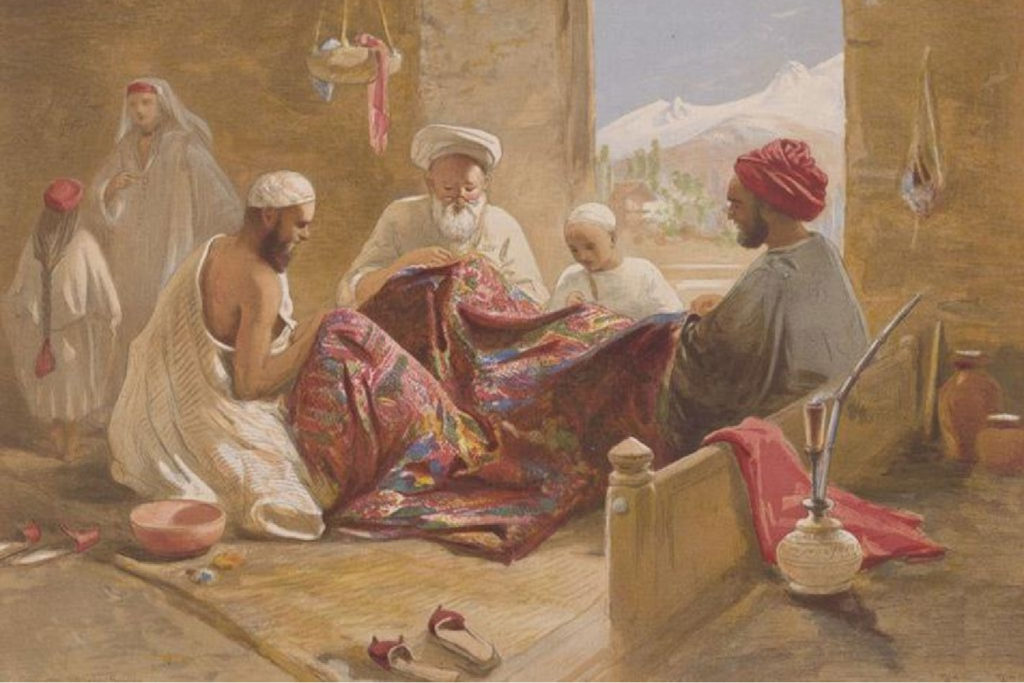
As the demand for Pure Pashmina shawls from Kashmir increased much, especially during the 18th century, many traders started making fake Pashmina shawls. These were shawls made from pure Cashmere and some other fibres. Either wool was mixed with Cashmere to make a fake Pashmina shawl, or woollen shawls were treated with softeners and sold as Pashmina shawls.
A new catastrophe by the name of Power Loom started in Kashmir, and Pashmina shawls were now made on a power loom. Note that the fine and gentle threads of Pashmina could only be handled manually, as the machine was too strong for a Cashmere fibre. The diameter of the fibre is just 12 to 16 microns, and as such, machine strain was too harsh for Pashmina. The power loom did ease the manual work, but the purity of Pashmina shawls was gone. Traders and manufacturers now used the power loom to weave the shawls from Cashmere threads, but mixed with them strengthening fibres of silk or nylon to avoid tearing of the Cashmere fibre. As such, these shawls remained just an imitation of the real art of Pashmina. But since these were cheap, owing to less use of Cashmere fibre, people actually fell for this conspiracy!
The ordeal of Pure Pashmina shawl makers
Pashmina shawls from Kashmir are not just pieces of art. The artisans of Pure Pashmina blend unparalleled artistic skills with immense practical functionality. But the bastardization of this timeless fabric has many patrons being cheated as Pashmina is being misrepresented to them. This unique and distinctive artful work of Pashmina shawl making requires decades of training on all processes that go into making it. This includes training in spinning, weaving, shearing of wool from the goat and more. But the cheap replica wraps peddled by traders look exactly the same and even feel like Cashmere. Hence, these are damaging the art as well as the skill of its makers.
The ordeal of Pure Pashmina Patrons
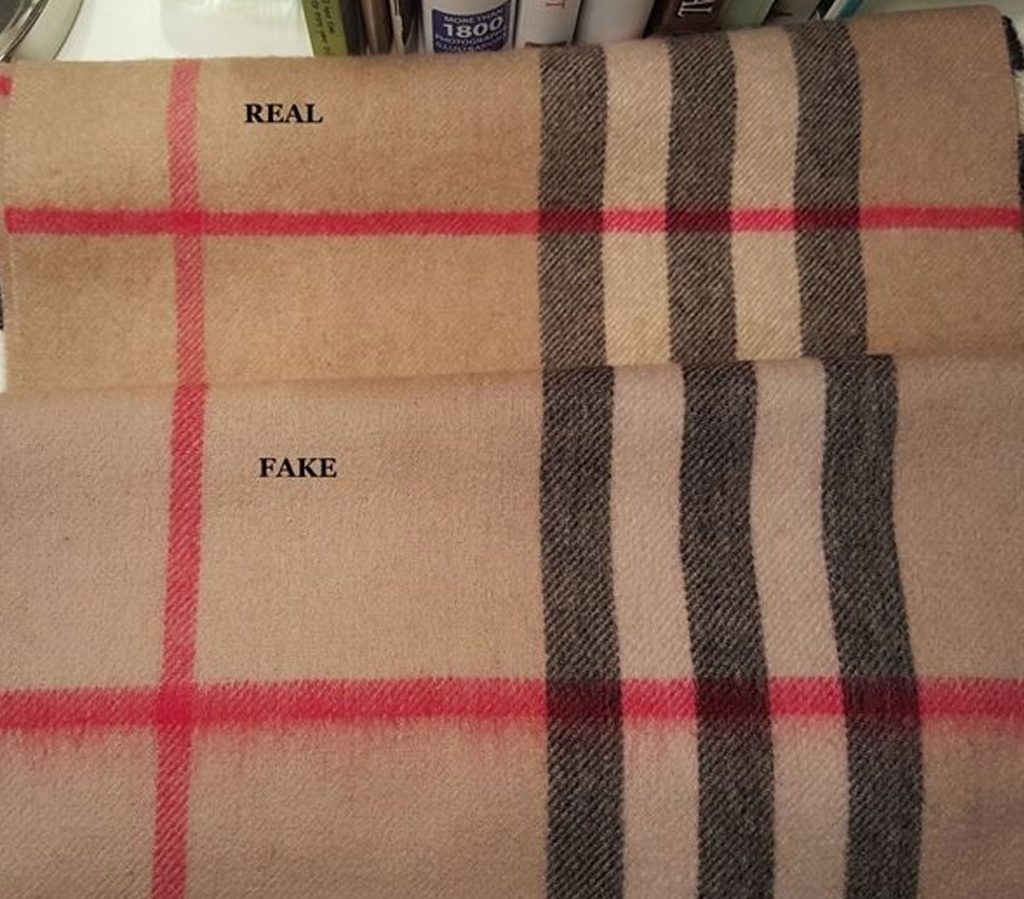
Buyers, too, confused with fake and pure, have switched to alternatives. This has brought more cataclysm to the glory that the art enjoyed once when fakes were not available. Even though the fake shawl at times appears to be more alluring to the eyes, the real admirers of this ancient craft have always looked for pure pieces. In search of the original Pashmina shawl, often admirers get cheated and realise this when they already make purchases. this is disheartening for the audience, and many of them have decided to invest in Pashmina at all, owing to the deception.
Pure Pashmina shawls last for an entire lifetime. But when it comes to fake and counterfeit products, they hardly last for a few years. When the price paid by the customer is compared to the quality, it leads to more discouragement on part of the customer, and he/she promises to invest in Pashmina again. These episodes have given a big blow to the overall reputation of Pashmina art, and everyone today believes that it is extremely challenging to get a pure Pashmina.
Original, Pure and authentic Pashmina source?
For years now, there has been confusion among the masses about the terms Pashmina and Cashmere. To clear this, we go back in history, when Europeans fell in love with this fabric. Since they could not pronounce Kashmir as the locals did, they called the fine wool Cashmere, an anglicized version of the term Kashmir. Since then, the wool has been called Cashmere, and the transformation of this wool into luxury shawls, wraps or scarves is considered an art, and this art form is called Pashmina.
It was the 18th century when replicas of Pashmina shawls emerged for the first time. The cheap replicas misrepresented the pure ones, and hence the art lost its prominence and appeal. Realizing the harm that the art had suffered, the local government decided to uplift the art of handcrafting luxurious shawls again. Hence in 2008, Pashmina was registered under the Geographical Indication (GI), and now the shawls came with a GI tag. As per the Quality Manual for Kashmiri Pashmina published by Craft Development Institute (CDI) Srinagar, this registration is an acknowledgement of the fact that Pashmina from Kashmir is unique and is produced in a particular area (Kashmir), according to some traditional knowledge and skills that are specific to this region.
For the Kashmiri Pashmina with GI, there are a few specifications. A shawl can qualify to be a Kashmiri Pashmina shawl if:
- It is made of 100% Cashmere obtained from the under fleece of Capra Hircus (goat) having fineness up to 16 Microns.
- The Cashmere thus obtained is hand spun in Kashmir using traditional methods.
- The Cashmere yarn from spinning is handwoven over traditional handloom, native to Kashmir
The Miraculous growth of Pashm
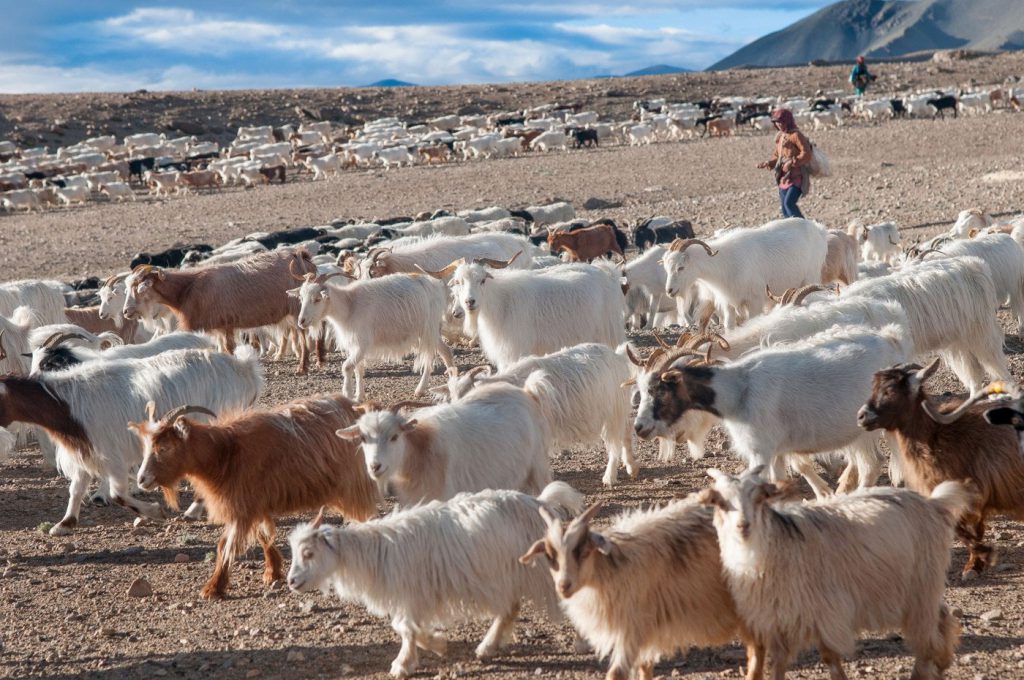
How miraculously the Capra Hircus goat of Ladakh grows Pashm is something to ponder over. It is the winter months when a soft and fine fleece covers the body of this rare goat and keeps it warm. Winters in Ladakh and harsh, and the temperature goes down to minus 40 degrees C. The answer to this cold is the growth of Pashm over the body of the goat, and help it survive these cruel days of winter.
As soon as Spring arrives in the month of March, the pure Pashm fleece rises above the goat's skin, making it easy to remove. Hence, during the moulting season, the goats shed their undercoat naturally. Apart from natural shedding, several combs are used to remove this fleece and free the goat of this warm burden. This grows again as soon as winter shows its first signs.
One Pashmina goat gives just 250 grams of Pashm on average. To handcraft a large shawl of 100*200 cm, wool from 3 to 4 goats is required. This wool is sent to Kashmir for processing.
Processing Pashm for Pure Pashmina Shawls
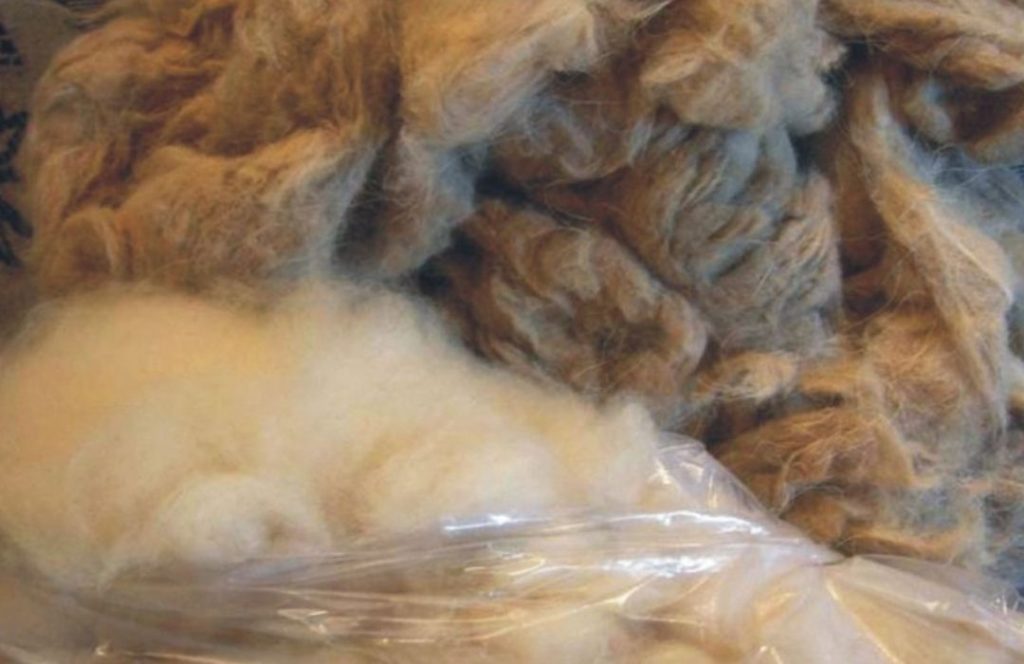
Pure Pashm threads from Ladakh arrive at Kashmir and need to be cleaned first. These are cleaned and sorted. Only the finest pure threads are used to make Pashmina shawls. Post cleaning, Pashm threads are soaked in a paste of rice powder and water. This gives these threads strength and shine, to be able to get processed later. After this process, the wool is again cleaned and sent for spinning.
Spinning is done by the womenfolk of Kashmir, who have decades of experience in the same. They load the threads onto a spinning wheel, and with the movements of their hands and the wheel, lumps of wool get transformed into fine yarn. The yarn is exceptionally soft, fine, and delicate. It measures just 12 to 16 microns. This yarn is perfect to be handwoven by men.
The yarn is sent for weaving. Men mount fine yarn onto the handloom and keep hand-weaving the same for a few days. After 3 or 4 days, plain Pashmina shawls come into existence. These are warm, lightweight, and ready to get further processed. Shawls can now be embroidered post washing them in spring water manually by expert washermen. Pure Pashmina shawls, embellished in a number of graceful ways, are now packed and sent for sale.
Importance of buying Pure Pashmina
It is not a choice to buy pure or fake Pashmina. It is in fact a necessity to buy only Pure Pashmina shawls. The reasons for this are many:
- Only pure Pashmina shawls are timeless. Fake pieces will wither in a few years, and your investment will get wasted.
- It is just Pure Pashmina shawls that are exceptionally warm. Fake shawls, which are a blend of synthetic fibres and Cashmere fibres do not provide such luxurious warmth.
- Pashmina shawls are expensive. No one wants to invest thousands of dollars for a shawl that is not even 100% Cashmere.
- Handmade is always special. Handmade pure Pashmina shawls are perfect gifts for your loved ones, and also for your own self when you need a little pampering. But fake shawls are machine-made. Neither do they serve as special gifts for your beloved, nor are they worth your personal attention and investment.
- Pure Pashmina is sustainable. this makes them worthy of every penny you pay for them. They are safe for the planet, its people and yourself. Pure Pashmina from Kashmir serves and empowers underprivileged women whose only source of income is spinning Cashmere.
As we conclude
All we can suggest to customers is to always invest in Pure Pashmina shawls. Here are a few ways to invest in pure Pashmina shawls.
If are new to Pashmina, and do not understand how to identify a pure Pashmina shawl, here are a few steps to keep in mind when you go out shopping.
Check the GI Tag
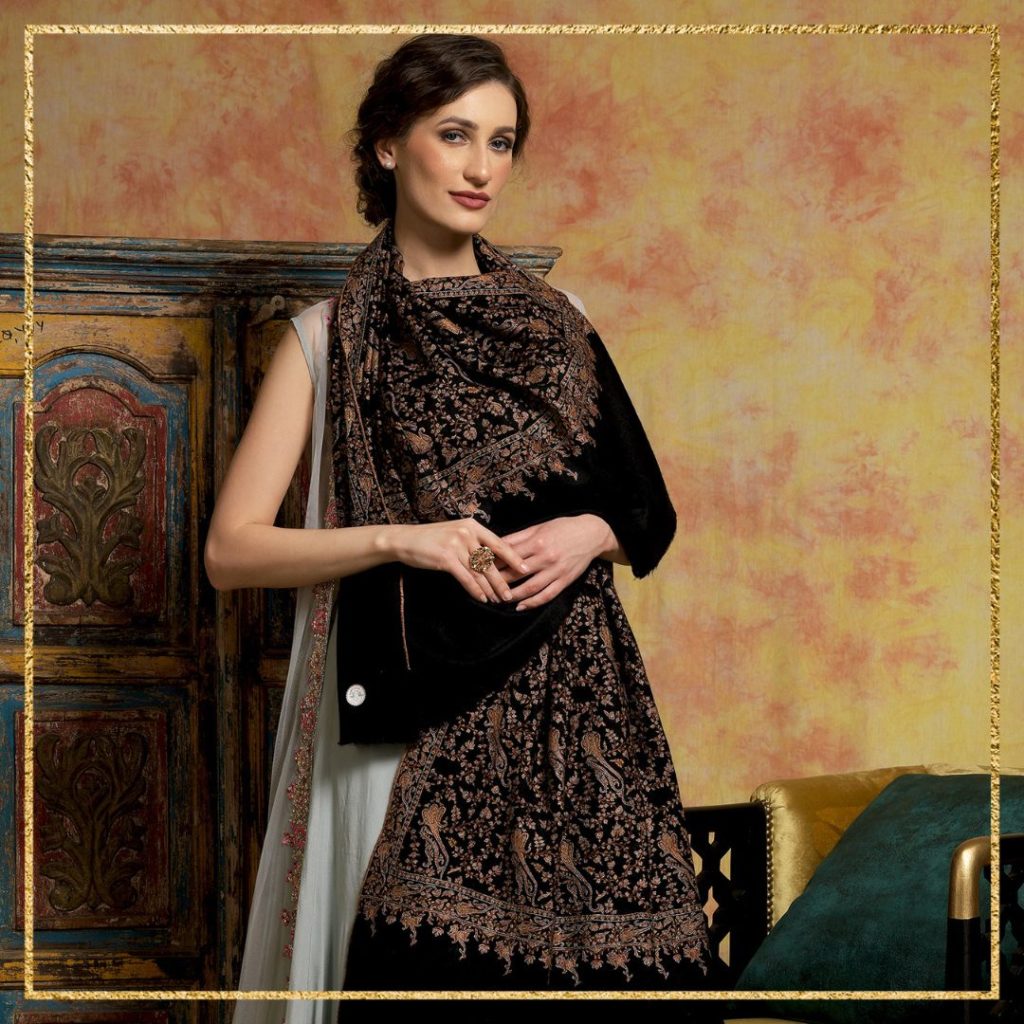
In 2008, the government bestowed a Geographical Indication (GI) stamp on pure Pashmina shawls. This was done to preserve this centuries-old art form. The GI stamp is only found on Pure Pashmina shawls and lies around the corners. Hence, if you find a GI stamp on a shawl, you are holding the purest form of Pashmina you can ever buy.
Also read: WHAT IS AN INDIAN PASHMINA?
Ask the seller for a purity certificate
If the GI stamp is not available, the seller should be able to produce a purity certificate, which mentions that the shawls have been certified by the concerned department. The department which is responsible for producing these certificates in Kashmir is the Craft Development Institute (CDI) in Srinagar.
Buying from Authentic Sellers
There is no doubt that newbies in the market won't provide a pure Pashmina. But it is always better to trust the long-living players in the market. Always check for the customer base of a particular seller, ask from his customers, and then only trust someone to provide the purest Pashmina shawls. However, it is better to check for GI tags and certificates first.
The love and care of a Pure Pashmina shawl will accompany you for an entire lifetime. A 30-year-old Pashmina shawl will tell you why mothers would gift their newlywed daughters their own Pashmina shawls. These would be a part and parcel of ancient traditions and the glorious heritage treasures that Pashmina has long been the crown of. No doubt about the fact that European royals and noble women would own hundreds of Pashmina shawls, and pass them on to their future generations as the most elegant souvenir, a reminder of a wonderful past.
Also read: HOW EXPENSIVE IS PASHMINA?